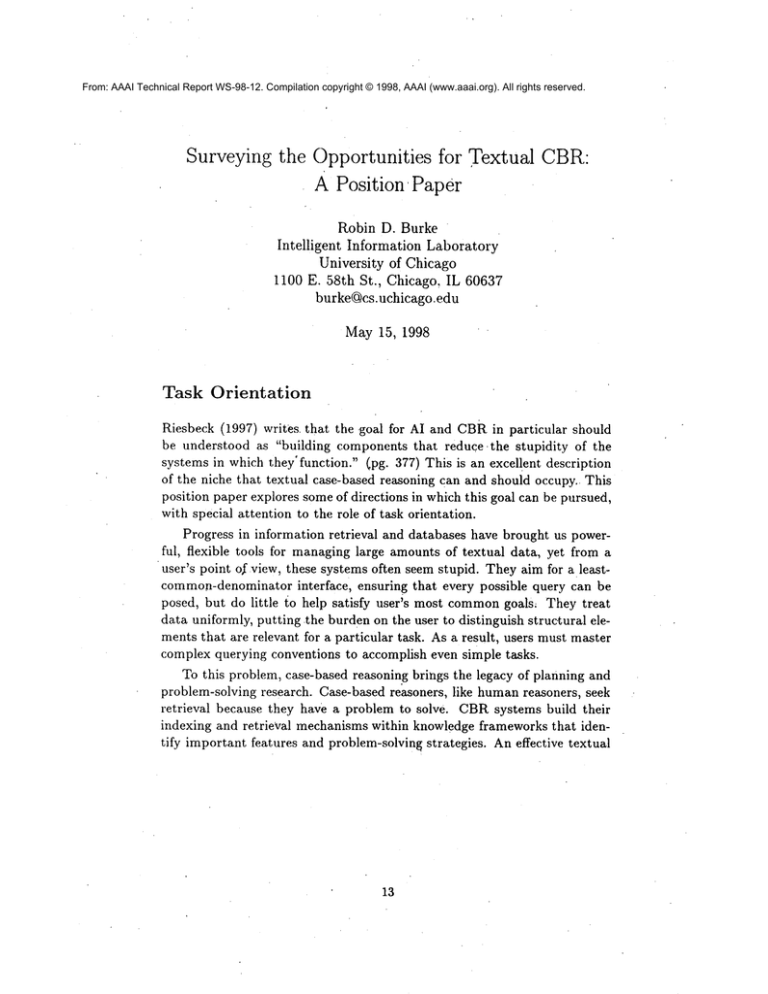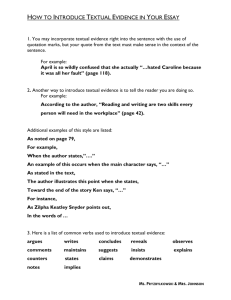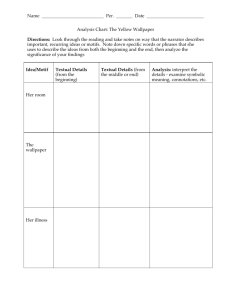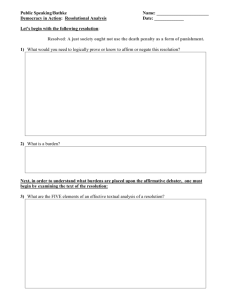
From: AAAI Technical Report WS-98-12. Compilation copyright © 1998, AAAI (www.aaai.org). All rights reserved.
Surveying the Opportunities for Textual CBR:
A Position Paper
Robin D. Burke
Intelligent
Information Laboratory
University of Chicago
1100 E. 58th St., Chicago, IL 60637
burke@cs.uchicago.edu
May 15, 1998
Task Orientation
Riesbeck (1997) writes, that the .goal for AI and cBR in particular should
be understood as "building components that reduce .the stupidity of the
systems in which they’ function." (pg. 377) This is an excellent description
of the niche that textual ease-based reasoning can and should occupy.. This
position paper explores someof directions in which this goal can be pursued,
with special attention to the role of task orientation.
Progress in information retrieval and databases have brought us powerful, flexible tools for managinglarge amounts of textual data, yet from a
user’s point of view, these systems often seem stupid. They aim for a leastcommon-denominatorinterface, ensuring that every possible query can be
posed, but do little io help satisfy user’s most commongoals, They treat
data uniformly, putting the burden on the user to distinguish structural elements that are relevant for a particular task. As a result, users must master
complex querying conventions to accomplish even simple tasks.
To this problem, case-based reasoning brings the legacy of planning and
problem-solving research. Case-based reasoners, like humanreasoners, seek
retrieval because they have a problem to solve. CBRsystems build their
indexing and retrieval mechanisms within knowledge frameworks that identify important features and problem-solving strategies. An effective textual
13
CBRsystem therefore will be one that focuses carefully on a particular task
and the knowledge requirements it imposes. Such a system will eschew flexibility and generality :[or precision and utility for a given group of users. In
this paper, I will discuss a few examples of working textual CBRsystems
that achieve this task focus and present the beginnings of a taxonomy of
different types of textual CBRsystems that might be built.
1Examples
One way that we can focus a system on a particular
task is to have the
system present a task-focused interface.
The interface
can structure the
user’s interaction
with a body of data in a way that supports problem:
solving.
For example, consider the ENTREEsystem (Burkel Hammond, & Young,
1997), a case-based information access system for finding restaurants.
The
system presents a page similar to that found in any other web-enabled
database: a HTMLform where the user can state their desires. Two things
distinguish it, however. With the exception of "Cuisine," the features from
which users select are not the same as those found in restaurant descriptions.
The restaurant descriptions
are too long and complicated to present every
selection to the user. Instead the interface generalizes over these details,
using abstract features in a way that will be familiar to those acquainted
with CBR. Secondly, the interfacepresents
the option: "I would like to eat
at a restaurant just like:" letting the user point the system at his or her
favorite eatery as a model.
The interaction that follows an initial user query also has its roots in
CBR:the user has a small set of "tweaks" that can be applied to the restaurants retrieved by the system. If the recalled resta:urant is too expensive, the
user can select the "Less $$’ tweak. If the restaurant looks too staid, the
user can choose "Livelier".
There are seven tweaks available.
The system
encourages an exploratory interaction
with the database, always grounded
in specific examples to which the user is responding.
ENTREE
does not provide full access, to every record in its database. It
does not allow the user to construct a convoluted query: "show me all the
1Wehave found the world-wideweb to be an excellent test-bed and data’source for
textual CBR.Both of the example textual CBRsystems mentioned here are accessible via the web: ENTREE
at http://infolab.cs.uchicago.edu/entree/;
FAQFINDERat
http://faqfinder.cs.uchicago.edu/
14
restaurants that have wheelchair access, valet parking, and serve Italian or
Mexican food." In some Cases, certain entries cannot be retrieved by any
query: the system tries ¯ to maximize quality achieved at a given price, so
restaurants that occupy uncompetitive positions in the quality/price tradeoff
will never be recalled. ENTREE
focuses the interaction on the typical goals
of a user: finding a restaurant that is a good value, serves the right kind’ of
food and has the right kind of atmosphere.
In building ENTREE,we had to encode knowledge about restaurants:
relations between concrete features like "good for singles" and abstract features like "Lively" and similarity relations between features such as the
connection between "Caribbean" and "Jamaican" cuisine.
This knowledge
is essential for the system to do its job, but it does not represent a major
knowledge acquisition hurdle.
A textual CBRsystem can also achieve task focus by structuring
its
handling of textual data. In’CBR, we understand that the best index to
a solution is the problem that it solves. If our textual CBRsystems are
designed to assist problem-solving, we can pay special attention to those
parts of a text that constitute
the problem and solution,
and treat the
problem as the best index. A problem-solving textual CBRsystem or textual
CBRadjunct to a human problem-solver will benefit from the structure
of
documents to the extent that it is possible to identify elements tliat are
good cues to the problem solved by a case. FAQ FINDER is a natural
language question-answering
system that uses USENETfrequent!y-asked
question files (Burke, et al. 1997). FAQfiles can be considered collections
of problem/solution (question/answer) pairs, excellent candidates for a casebased approach.
FAQ FINDER uses a combination
of matching techniques
to compare
user questions with the question/answer pairs in FAQfiles. Following standard information retrieval practice, the system uses a statistical
technique
comparing term vectors derived from the input and each question/answer
pair, but this measure is combined with a "semantic score." The semantic
score is derived from a comparison between questions only, and uses the
WordNet semantic network (Miller,
1995) to evaluate the semantic "distance" between the two questions. It would be computationally prohibitive
and noise-prone to extend this analysis to the entire question/answer pair,
but our research found that special attention to the question part of the QA
¯ pair yielded significant performance improvements over a uniform statistical
approach over the entire pair.
15
Taxonomy
of
Textual
CBR Systems
These examples indicate two directions that my colleagues and I have already
pursued in the textual CBR. Included below is a partial taxonomy of the
different types of systems that might be built. Each branch of the taxonomy
suggests a different task focus, and would profit from a different kind of user
interface and different text/case interpretation
technique. It is intended to
be suggestive, rather than exhaustive, and I welcome additions to the list:
Selection systems: Systems that help the user identify an entity of interest, where the entities are described largely in text and can be treated
as cases. ENTREEand the other FINDMEsystems from the Intelligent
Information Laboratory are simple examples of this category. A more
complex example: The magazine Consumer Reports regularly
generates text reviews describing and comparing the products in a given
category:
washing machines, for example. An textual
CBR system
could find the most recent reviews of the item of interest to the user
and organize the information to assist decision making.
Threat detection systems: Systems that help the user identify a possible
threat, based on textual descriptions of the activities of others. Example: Treating corporate press releases as cases, a textual CBRsystem
might enable a user to identify possible companies and products likely
to be a competitive threat in a particular market segment.
Pattern identification
systems: Systems that help the user locate patterns in textual items, such as building clusters of related items. Example: In large software projects, the bug database can be very large
and may be manage by a large geographically-distributed
group of
people. A textual CBR system helping to manage the database could
cluster and organize bugs as they are added, helping users determine if
a given bug has already been identified and perhaps fixed, and helping
developers identify aspects of a program that are particularly vulnerable to bugs.
Document assembly systems:
Systems that help the user assemble a
custom document from standard parts, such as legal boilerplate.
Example: a contract generator might have many textual elements of contracts labeled by the issues they address, such as liability, redress, etc.
A user would describe the terms of a contract and the system would
16
retrieve and assemble the necessary pieces. (Such a system Wouldalso
require a reasonably sophisticated text-case adaptation mechanism.)
Question answering systems: Systems that treat texts as answers, to
be retrieved in response to specific questions. Example: The FAQ
FINDERsystem mentioned above and also the Chicago Information
Exchange (Kulyukin, in preparation).
Traps
to avoid
As the above list shows, there is muchterritory to be explored under the
banner of textual CBR,and manyavenues to explore. In the spirit of McDermott’s classic "Artificial Intelligence Meets Natural Stupidity" (McDermott,
1981), I would like to volunteer a few of the conceptual hazards that I have
encountered in my experience intextual CBRin hopes of helping others
avoid them:
Wishful natural language understanding: In building systems that deal
with text, it is easy to end up in the situation where the design requires that the system understand the text it processes, in the sense of
being able to build a deep representation of its contents. For example,
a case-based system using newspaper stories might need indices that
explain the events occurring in the stories. For some text corpuses
and some tasks, it may be possible for an NLP-intensive approach
to succeed, but we should understand that barring significant breakthroughs in NLPthese will be the exceptional rather than the typical
applications of textual CBR,and that such systems will by necessity
be natt~ral language systems first and case-based reasoners second.
Underestimating IR: Historically, information retrieval and artificial intelligence have been Seen as making Competingclaims about what can
be done with corpuses of text, with each disparaging the techniques
of the other. This would be an unfortunate trap for textual CBRto
fall into. A thorough grounding in IR methods and results should be
considered fundamental training for anyone interested in.textual CBR.
For example, many of the obvious technique s for improving the termlevel representation of a documenthave already been well-investigated
in IR: detection of acronyms, proper names, phrase recognition, etc.
17
with results that are not always intuitive.
to reinvent the wheel or, worse, the Edsel.
It Would be foolish
for us
Overestimating
IR: On the other hand, there is an equally-problematic
trap to be found in ignoring the fundamental task and problem-solving
orientation that CBRbrings to the*retrieval question. Information retrieval research finds little significance in targeted or "ad-hoc" systems
that sacrifice generality in seeking to improve performance on a particular corpus, yet this is precisely where textual CBR’s benefits are
to be found. It is important therefore to understand the limits of the
applicability
of some IR results to research in textual CBR.
Evaluation methodology is one area in particular
where CBRand IR
are destined to clash. Information retrieval metrics, particularly the
standard dyad of recall and precision,
carry with them fundamental
assumptions about the nature and purpose of retrieval.
In the case of
FAQFINDER,a null result (no answer in the FAQfile) is potentially
of great importance: the system may be able to route the question
to an individual or to an appropriate newsgroup for answering. The
standard metrics do nothing to help us assess this aspect of the system’s performance because the IR metrics are based on the notion o.f
relevance (finding related material), not the notion of problem-solving
(answering a specific question).
Conclusion
The management and recall of text, is an area where CBRtechniques have already shown promise, and where the natural strengths of the CBRapproach
fit the problelns encountered. I believe the problem-solving orientation of
CBRwill remain its biggest asset in building useful systems. To make full
use of this asset we will need to develop our understanding of the kind of
problem-solving processes that our systems might serve and what support
these processes need from a textual case base. The taxonomy given above
is a first step in this direction.
18
References
Burke, RI, Hammond, K., Kulyukin, V., Lytinen, S., Tomuro, N., and
Schoenberg, S. (1997) Question Answering from Frequently-Asked
Question Files: Experiences with the FAQFinder System. AI Magazine, 18(2),
pp. 57-66.
Burke, R., Hammond, K., and Young, B. (1997) The FindMe Approach
Assisted Browsing. IEEE Expert, 12(4), pp. 32-40.
Kulyukin, V. in preparation.
Building Organization-Embedded
Answering Systems. PhD thesis. University of Chicago.
McDermott, D. (1981) Artificial
Intelligence
Haugeland, ed. Mind Design, pp. 143-160.
Miller,
cations
G. A. (1995) WordNet: A Lexical
of the ACM, 38(11).
Question-
Meets Natural Stupidity.
Database for English.
In
Communi~
Riesbeck, C. (1997) What Next? The Future of CBR in Post-Modern AI.
In D. Leake, ed. Case-Based Reasonin#: Experiences, Lessons and Future
Directions, pp. 371-388.
19





